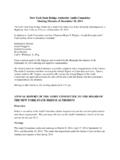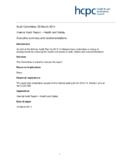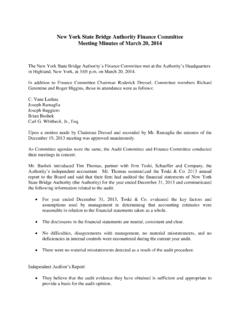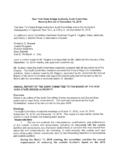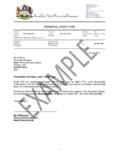Transcription of Internal Audit of UNICEF Treasury Management
1 Internal Audit of UNICEF Treasury Management July 2013 Office of Internal Audit and Investigations (OIAI) Report 2013/25 Internal Audit of UNICEF Treasury Management (2013/25) 2 _____ Summary The Office of Internal Audit and Investigations (OIAI) has conducted an Audit of the Division of Financial & Administrative Management (DFAM) Treasury Management for the period January 1, 2011 to December 31, 2012. The Audit sought to assess the governance, risk Management , and control processes over Treasury Management . The Audit was conducted between 25 February and 9 May 2013.
2 Treasury Management strives to identify, manage and mitigate financial risks to which UNICEF is exposed, while at the same time generating a market return on its liquidity. These risks are primarily related to maintaining adequate liquidity while managing investments and foreign exchange fluctuations. UNICEF has a Financial Advisory Committee (FAC) consisting of Internal staff members of UNICEF whose responsibilities do not include daily interaction with financial markets. The FAC advises Treasury Management with respect to investment strategies and performance benchmarks. The committee approves bank and counterparty relationships and limits, investment guidelines and Treasury policies.
3 UNICEF is voluntarily funded and does not have the authority to borrow funds for purposes of covering cash flow deficiencies or to leverage its cash position. The Treasury Management manages funds liquidity to ensure that operating cash-flow requirements are met. Funds not immediately required for operations are invested in a manner designed to preserve capital and ensure sufficient liquidity, while earning a rate of return commensurate with the conservative risk tolerance defined by the Financial Advisory Committee. In 2011-2012, the Treasury Management was responsible for: managing more than US$ billion in annual UNICEF receipts and disbursements; transacting more than US$ billion in foreign currency trades (US$ billion in 2011 and US$ billion in 2012); and managing on average US$ billion (US$ billion in 2011 and US$ billion in 2012) in investments.
4 Total revenues generated by investment activity and foreign currency trading strategies were US$ million in 2012 and US$ million in 2011. The Treasury Management manages 13 convertible currencies and is responsible for foreign currency replenishments for country offices. In 2011, 26 currencies were purchased for 31 country offices; and 70 currencies were purchased for 82 country offices in 2012. In 2012, about 63 percent of the funds received were in United States dollars (US$), with 37 percent in other currencies. Ninety percent of disbursements were made in US$ and 10 percent in other currencies.
5 Action agreed following Audit As a result of the Audit , and in discussion with the Audit team, DFAM has decided to take a number of measures, including two to address the following high-priority issues: Overall, the principal weakness and opportunity for improvement in Treasury Management operations results from a lack of adequate technology. This creates unnecessary manual work, reducing the time available for more critical tasks. Technology difficulties and limitations have diminished Treasury Management 's ability to optimize investment portfolio returns and manage account balances, due Internal Audit of UNICEF Treasury Management (2013/25) 3 _____ to a lack of cash forecasting tools.
6 Further, senior Management oversight over the effectiveness of risk mitigation controls has been hindered by the inability to efficiently produce compliance reports. There were 140 returned payments in 2011 for a total of US$ million, and 171 in 2012 totalling US$ million, because of incorrect payment instructions. This happened because of the decentralization of the Vendor Master Database and inadequate controls over payroll payment instructions. It is recommended that control measures be ensured over the vendor master database (including consideration of the centralization of the vendor database) and that payroll payments be subject to pre-notification entry.
7 Conclusion The Audit concluded that overall, subject to implementation of the agreed actions described, the controls and processes over UNICEF s Treasury Management were generally established and functioning during the period under Audit . The measures to address the issues raised are presented with each observation in the body of this report. DFAM has prepared action plans to address the issues raised, and will work with OIAI to monitor implementation of these measures. Office of Internal Audit and Investigations (OIAI) July 2013 Internal Audit of UNICEF Treasury Management (2013/25) 4 _____ Contents Summary 2 Objectives and scope 5 Audit observations 5 Risk Management 5 Satisfactory key controls 5 Quantitative risk analyses 6 Governance processes 8 Financial Advisory Committee membership 8 Safeguarding of financial assets 9 Satisfactory key controls 9 Returned payments 9 Banking fees 10 Bank balances 11 Bank agreements 12 Appropriateness and adequacy of control processes 13 Satisfactory key controls
8 13 Relationship agreements 13 Sufficient of liquidity to meet operations requirements 15 Cash flow forecasts 15 Optimization of investment portfolio returns 17 Satisfactory key controls 17 Cash flow investments 17 Compliance with regulations, guidelines and rules 19 Satisfactory key controls 19 Treasury position and limits compliance reports 19 Reporting Treasury performance against benchmark 20 Return on investment 20 Annex A: Methodology, and definition of priorities and conclusions 21 Internal Audit of UNICEF Treasury Management (2013/25) 6 _____ purchases of foreign currency against Bloomberg1 average exchange rates; and measuring the incremental value realized with centralization of foreign currency purchases for country offices.
9 UNICEF s investment policy prescribes that up to 10 percent of the investment portfolio may be comprised of structured deposits. Structured deposits, which have been used by UNICEF since 2003, are subject to investment diversification and counterparty risk guidelines provided in The Treasury Cash & Investment Management Guidelines and Procedures. UNICEF uses structured deposits as an investment vehicle to manage foreign currency risk and operational cash flow requirements, and to enhance investment yield. A structured deposit is a time deposit placed with an approved counterparty. At the time of the deposit, UNICEF sells the counterparty an option to return the principal and interest on the deposit in an alternative currency at a specified price.
10 The option purchased allows the counterparty to pay in either currency upon maturity. The yield on these investments improves because income earned includes both interest on the deposit and the option premium. Foreign currency (FX) open exposure limits have been established to limit risk and are regularly reviewed by the Financial Advisory Committee. UNICEF s guidelines prohibit foreign currency trading for speculative purposes. FX transactions may be undertaken only to meet actual and anticipated receipts and disbursements. The Audit did not note any exceptions to the established limits during compliance testing.










